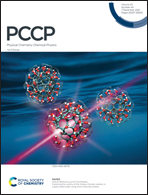Photodissociation of the methyl radical: the role of nonadiabatic couplings in enhancing the variety of dissociation mechanisms
Abstract
The nonadiabatic photodissociation dynamics of the CH3 (and CD3) radical from the 3pz and 3s Rydberg states is investigated by applying a one-dimensional (1D) wave packet model that uses recently calculated ab initio 1D electronic potential-energy curves and nonadiabatic couplings. Calculated predissociation lifetimes are found to be too long as compared to the experimental ones. The 1D dynamical model, however, is able to predict qualitatively and explain the fragmentation mechanisms that produce the hydrogen-fragment translational energy distributions (TED) measured experimentally for the ground vibrational resonance of the 3pz and 3s Rydberg states (CH3(v = 0, 3pz) and CH3(v = 0, 3s)). The CH3(v = 0, 3pz) TED found experimentally displays a rather large energy spreading, while the experimental CH3(v = 0, 3s) TED is remarkably more localized in energy. The present model also predicts a widely spread CH3(v = 0, 3pz) TED, produced by a complex dissociation mechanism which involves predissociation to one dissociative valence state through a nonadiabatic coupling, as well as transfer of population to a second valence state through three conical intersections. Also in agreement with experiment, the model predicts a rather localized CH3(v = 0, 3s) TED because the conical intersections no longer operate in this photodissociation process, and predissociation occurs only into a single valence state. Another complex dissociation mechanism is predicted by the model for initial CH3(v > 0, 3s) and CD3(v > 0, 3s) resonances. In this case the mechanism is gradually activated, as vibrational excitation increases, by the interplay between the two nonadiabatic couplings connecting the 3s and 3px,y Rydberg states with the dissociative 2A1 valence state, and produces complex TEDs with signals from several resonances of both 3s and 3px,y. Thus the present 1D quantum model reveals a rich photodissociation dynamics of methyl, where a variety of complex fragmentation mechanisms is favored by the presence of different nonadiabatic couplings between the electronic states involved.



 Please wait while we load your content...
Please wait while we load your content...